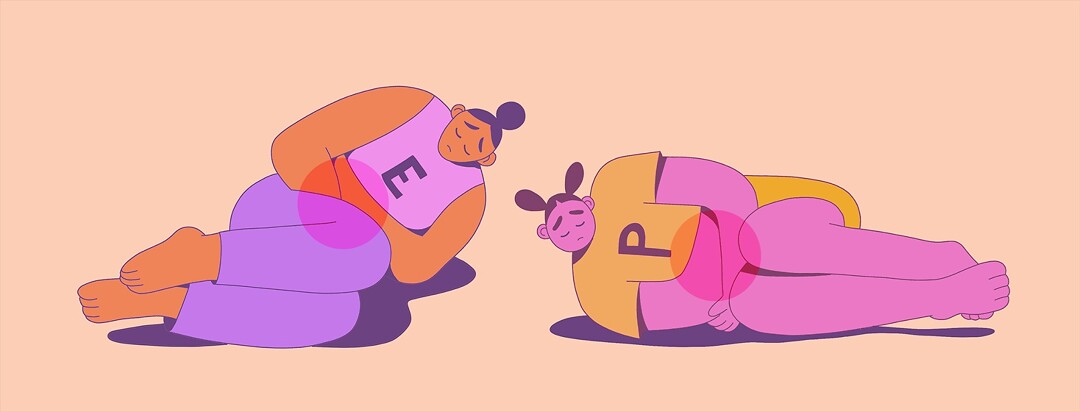Endometriosis and Polycystic Ovary Syndrome (PCOS): What Is the Difference?
Endometriosis and polycystic ovarian syndrome (PCOS) are 2 separate gynecologic disorders that are similar in many ways. They both affect people who are in their reproductive years. They also have some of the same symptoms, like heavy menstrual cycles and difficulty getting pregnant.1,2
It is even possible to have endometriosis and PCOS at the same time. While the conditions have similarities, there are also clear differences between them.3
Symptoms of endometriosis
Endometriosis happens when tissue similar to the tissue from the lining of the uterus grows in other parts of the body. This growth affects the reproductive organs like the fallopian tubes and ovaries. But it can also occur anywhere between the bladder, uterus, and vagina.4
This leads to painful and uncomfortable symptoms like:2,4,5
- Painful and heavy periods
- Pain in the lower abdomen, pelvic area, and back during a menstrual cycle
- Pain during or after sex
- Menstrual cramps that may last up to 2 weeks before a period and during a menstrual cycle
- Stomach problems like diarrhea, constipation, and bloating, mainly during a menstrual cycle
- Pelvic pain
The exact cause of endometriosis is unknown.4
Symptoms of PCOS
PCOS occurs when abnormal growths, or cysts, develop on and around the ovaries. These cysts can disrupt a person's ovulation cycle by preventing the release of an egg each month. This can lead to problems becoming pregnant.2,4
Several factors may cause PCOS, including:2,4,6
- Problems processing insulin (a hormone that helps control blood sugar levels)
- Obesity
- An irregular menstrual cycle
- Overproduction of a hormone called androgen
There is also a greater chance of developing PCOS if there is a family history. For example, it is common for sisters or mothers and daughters to have PCOS.6
Other symptoms of PCOS include:2,7
- Irregular periods
- Weight gain
- Hair growth on the face, chest, or stomach
- Acne
- Difficulty getting pregnant
According to a 2018 study, 5 to 20 percent of women of childbearing age worldwide live with PCOS. If left untreated, PCOS can lead to an increased risk of endometrial cancer (cancer of the uterine lining).8,9
Diagnosing endometriosis and PCOS
While endometriosis and PCOS are both common, they often go undiagnosed. Several exams and tests are needed to find out whether a person has endometriosis and/or PCOS. Your doctor might perform 1 or all of the following to reach an accurate diagnosis.
Exams and tests used to diagnose endometriosis include:2,4
- Full medical history
- Pelvic exam
- Imaging tests like an ultrasound, which looks at internal organs and tissues
- Blood tests
- Laparoscopy
Exams and tests used to diagnose PCOS include:6,7,9
- Full medical history
- Pelvic exam
- Blood tests
- Ultrasound to look at ovaries and uterus
Treatment options
There is no cure for endometriosis and PCOS. However, there are certain treatments that may help with symptoms.
Treatments for endometriosis include:2,4
- Pain medicine – Over-the-counter drugs like ibuprofen or Tylenol may help manage painful symptoms.
- Birth control or other hormonal therapies
- Surgery, such as laparoscopy
Treatments for PCOS include:6,7
- Weight loss – Losing weight may help regulate periods and improve ovulation.
- Fertility treatment – Medicine to increase ovulation may help with infertility.
- Birth control – Prescription birth control can help regulate periods and reduce acne.
- Insulin management– Prescription drugs can help the body respond to insulin, help balance hormone levels, and help improve ovulation.
- Surgery – In some cases, surgery may be needed to remove cysts.
Because every person experiences different symptoms, treatment is often tailored. Treatment also depends on a person’s age, other health problems, and whether they want to become pregnant. If you have any of the above symptoms, speak with your gynecologist. They can help you with next steps.

Join the conversation